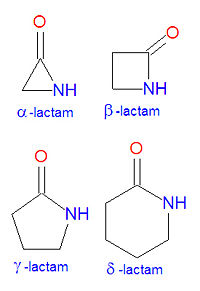Lactam: Difference between revisions
imported>David E. Volk |
mNo edit summary |
||
| (9 intermediate revisions by 4 users not shown) | |||
| Line 1: | Line 1: | ||
{{subpages}} | {{subpages}} | ||
{{Image|Lactams.jpg|right|200px|<small>Lactam structures.</small>}} | |||
In chemistry, a '''lactam''' is a cyclic [[amide]]. The name is derived from two chemical terms, [[lactone]], referring to a cyclic ketone, and [[amide]], a compound containing a [[nitrogen]] atom next to a [[carbonyl]] group. Lactams are named according to the size of the cyclic ring in the lactam: <math>\alpha</math>-lactams, <math>\beta</math>-lactams, <math>\gamma</math>-lactams and <math>\delta</math>-lactams contain rings made of three, four, five or six atoms, respectively. <math>\alpha</math>-lactams are also called aziridinones. Many widely used antibiotic drugs, including the[[penicillin]]s and [[cephalosporin]]s, owe their activity to the presence of a <math>\beta</math>-lactam structure. The lactams may have substitutions added to the nitrogen atom or any of the non-carbonyl carbon atoms in the base structure. | In chemistry, a '''lactam''' is a cyclic [[amide]]. The name is derived from two chemical terms, [[lactone]], referring to a cyclic ketone, and [[amide]], a compound containing a [[nitrogen]] atom next to a [[carbonyl]] group. Lactams are named according to the size of the cyclic ring in the lactam: <math>\alpha</math>-lactams, <math>\beta</math>-lactams, <math>\gamma</math>-lactams and <math>\delta</math>-lactams contain rings made of three, four, five or six atoms, respectively. <math>\alpha</math>-lactams are also called aziridinones. Many widely used antibiotic drugs, including the [[penicillin]]s and [[cephalosporin]]s, owe their activity to the presence of a <math>\beta</math>-lactam structure. The lactams may have substitutions added to the nitrogen atom or any of the non-carbonyl carbon atoms in the base structure. | ||
== Synthesis of lactams == | |||
=== Synthesis of alpha-lactams === | |||
{{Image|Alpha lactam synthesis.jpg|right|400px|<small>A general purpose alpha-lactam synthesis</small>}} | |||
The cyclization reaction of an <math>\alpha</math>-haloamide precuror in the presence of [[sodium hydride]] and [[15-crown-5 ether]] at room temperature in [[dichloromethane]] (CH<sub>2</sub>Cl<sub>2</sub>) is a high-yielding, general route to <math>\alpha</math>-lactam (aziridinone) products. The hydrogen gas and sodium halide by-products are readily removed.<ref>{{cite journal|journal=Synthesis|author=V. Cesare, T. M. Lyons and I. Lengyel|year=2002|volume=2002|pages=1716-1720|title=A High-Yielding General Synthesis of α-Lactams}}</ref> | |||
== Antibiotics == | == Antibiotics == | ||
{{Image|Cephalosporin base.jpg|right|200px|<small>Base structure of all cephalosporins.</small>}} | |||
The <math>\beta</math>-lactam forms the center structure of many antibiotic drugs, such as the [[cephalosporin]]s and the [[penicillin]]s, as shown above. In the penicillins, the non-lactam ring is one atom smaller compared to the cephalosporins. The activity of cephalosporins, penicillins, and some other antibiotics are due to the presence of the beta-lactam, which binds irreversibly, via acylation, to penicillin-binding proteins, thereby inhibiting the peptidogycan layer of bacterial cell wall synthesis. Cephalosporins and penicillins are often made semi-synthetically, using a core structure obtained from a natural organism, such as a fungus, due to the difficulty and expense of synthesizing these lactams. | The <math>\beta</math>-lactam forms the center structure of many antibiotic drugs, such as the [[cephalosporin]]s and the [[penicillin]]s, as shown above. In the penicillins, the non-lactam ring is one atom smaller compared to the cephalosporins. The activity of cephalosporins, penicillins, and some other antibiotics are due to the presence of the beta-lactam, which binds irreversibly, via acylation, to penicillin-binding proteins, thereby inhibiting the peptidogycan layer of bacterial cell wall synthesis. Cephalosporins and penicillins are often made semi-synthetically, using a core structure obtained from a natural organism, such as a fungus, due to the difficulty and expense of synthesizing these lactams. | ||
==References== | |||
{{reflist}} | |||
[[Category:Reviewed Passed]][[Category:Suggestion Bot Tag]] | |||
Latest revision as of 11:00, 9 September 2024
In chemistry, a lactam is a cyclic amide. The name is derived from two chemical terms, lactone, referring to a cyclic ketone, and amide, a compound containing a nitrogen atom next to a carbonyl group. Lactams are named according to the size of the cyclic ring in the lactam: -lactams, -lactams, -lactams and -lactams contain rings made of three, four, five or six atoms, respectively. -lactams are also called aziridinones. Many widely used antibiotic drugs, including the penicillins and cephalosporins, owe their activity to the presence of a -lactam structure. The lactams may have substitutions added to the nitrogen atom or any of the non-carbonyl carbon atoms in the base structure.
Synthesis of lactams
Synthesis of alpha-lactams
The cyclization reaction of an -haloamide precuror in the presence of sodium hydride and 15-crown-5 ether at room temperature in dichloromethane (CH2Cl2) is a high-yielding, general route to -lactam (aziridinone) products. The hydrogen gas and sodium halide by-products are readily removed.[1]
Antibiotics
The -lactam forms the center structure of many antibiotic drugs, such as the cephalosporins and the penicillins, as shown above. In the penicillins, the non-lactam ring is one atom smaller compared to the cephalosporins. The activity of cephalosporins, penicillins, and some other antibiotics are due to the presence of the beta-lactam, which binds irreversibly, via acylation, to penicillin-binding proteins, thereby inhibiting the peptidogycan layer of bacterial cell wall synthesis. Cephalosporins and penicillins are often made semi-synthetically, using a core structure obtained from a natural organism, such as a fungus, due to the difficulty and expense of synthesizing these lactams.
References
- ↑ V. Cesare, T. M. Lyons and I. Lengyel (2002). "A High-Yielding General Synthesis of α-Lactams". Synthesis 2002: 1716-1720.






